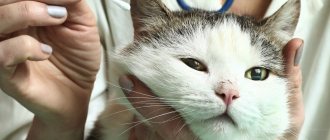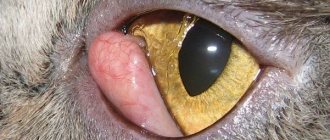Typical Factors
- Hematoma formed due to injury. Injuries in representatives of the cat family leading an active lifestyle on the street are a common occurrence. The fight for territory, for the location of females and other delights of life lead to fights between cats. Usually the lion's share of bites and scratches occurs on the head. Ears, lips and eyes are the most sensitive places, they have the hardest time. And now the cat’s face is swollen. There are times when a fight ends with a broken jaw. The consequences of this are noticeable immediately - the lower part of the “face” increases in size, and the cat does not allow you to touch the sore spot. It is better not to hesitate and immediately take him to see a doctor. Due to a broken jaw, the animal will not be able to exist normally, take pity on it and do not make it suffer in pain. Moreover, a focus of infection may arise at the site of open wounds. And then the internal inflammatory process will begin. We'll talk about it a little later.
- Allergy. There are allergy sufferers among animals, as well as among people. There are especially many of them in urban environments, when oxygen access to the apartment is limited. Allergies can arise from anything, from pet shampoo to new luxury food. Yes, even in the premium segment there are ingredients that cause allergic reactions. There was a case when a cat's face became swollen after changing the brand of litter for the tray. So make all innovations with an eye on the animal’s condition. As a treatment, veterinarians usually prescribe a conservative method - a course of antihistamines, which will need to be taken for some time until the situation improves.
- Acne or inflammation of the sebaceous gland ducts. Do you think acne is a problem for teenagers? No, cats get it too. On their muzzle they have sebaceous glands that are connected to hair follicles. They give the animal's fur water-repellent properties and prevent dirt from accumulating on it. An impressive portion of these glands are located on the chin. When their ducts become clogged, black spots appear. They are otherwise called comedones. Already at this stage, the disease requires close attention and treatment. But owners do not always pay attention to the black spots on the cat’s chin. And soon they may observe folliculitis in their animal. With it, pus accumulates in the voids of the hair follicles. Here the symptom is already obvious, the cat’s face is swollen.
- Insect or snake bite. While walking outside with domestic cats, its permanent inhabitants will want to get to know each other better. Even an innocent trip to the countryside can bring a lot of surprises for an unprepared owner. For example, he will suddenly notice that the cat's muzzle is swollen on one side. Perhaps this is due to the fact that the pet decided to play with biting insects and got too carried away. A wasp sting easily turns a pretty face into a swollen something, not to mention gadflies, horseflies and bees.
There are also poisonous and not so poisonous snakes in the dacha area. They do not show aggression if you do not touch them, but who will explain this to the animal? If you see that a cat has been bitten by a snake, try to remember its color. This will come in handy when you visit the veterinarian. Yes, if you are bitten by a snake, you should go to the clinic. Even if you are sure that it was not poisonous.
What is edema?
Fluid retention in animal tissues occurs for various reasons.
There are two mechanisms for fluid accumulation:
- hydrostatic, associated with increased pressure in small vessels;
- hypoprotemic, associated with a violation of the protein content in the liquid part of the blood (plasma).
In the latter case, the permeability of small vessels increases due to inflammation, disorders of nervous regulation or toxic lesions.
The fluid that accumulates in the tissues can also be different:
- blood;
- lymph;
- pus.
Edema may vary in area and symmetry:
- they are limited (localized) and generalized (general);
- symmetrical and asymmetrical (for example, only one paw swells).
Limited swelling affects a small area of the body or organ. General ones cover large areas and indicate serious illnesses and a poor prognosis for the life of the animal.
Edema is caused by a condition called pre-edema. Predotec describes the state of preliminary accumulation of fluid in organs or tissues.
Prevention
The best treatment is prevention. It will allow you to keep your face normal and your health intact.
Free access to the street for cats should be kept to a minimum. This will help protect the animal from bites from poisonous snakes, insects, cat fights, injuries from cars or bicycles, etc. Those cats who were recently kittens are especially prone to jokes and desperate attempts to assert themselves on the street. They have no street experience and cannot assess the level of threat.
Allergies can be predicted, of course. Difficult. But it is possible to minimize the consequences of its occurrence. Introduce any new food or products into your pet’s diet in small portions, do not throw out everything you have. And let the new food digest, observe the animal’s condition throughout the day. If no manifestations of allergy appear, then you can continue to give this product.
Examine your pet regularly, keep the condition of its fur, teeth, and epidermis under control. Visit your veterinarian at least a couple of times a year. Do not give your cat human medications. Not everything that is good for humans is suitable for animals. Be sure to consult before starting a course of taking any medications.
Give your animal anti-helminth medications and do not allow parasites to settle in your pet’s body. Add this to your regular to-do list. If preventative measures do not work and swelling on the face occurs, do not delay, seek help. Sometimes a timely trip to the veterinary clinic can save you from sad consequences and quickly return your pet to a healthy appearance.
Rhinotracheitis, calcivirosis and other upper respiratory tract infections
Feline upper respiratory tract infection is a general term for respiratory infections caused by one or more viral or bacterial agents.
The infection may be caused by one or more viral and/or bacterial agents. The most common viruses that cause upper respiratory tract infections in cats are:
- Herpesvirus type 1 is also known as feline rhinotracheitis virus or FVR.
- Calcivirosis (FCV).
The most common bacteria that cause upper respiratory tract infections in cats are:
- Bordetella bronchiseptica.
- Chlamydophila felis.
Rhinotracheitis and calcivirus cause approximately 90% of all secondary respiratory tract infections in cats. Other, less common pathogens that can lead to purulent discharge and inflammation of the nose are:
- Mycoplasmosis.
- Rotavirus.
Causes of swelling
Swelling never occurs normally. The appearance of tissue swelling is always preceded by a pathological process.
Allergic edema
One of the most common causes of edema in cats is an allergic reaction. She might be local. But often an allergic reaction occurs in the form of angioedema. To the bite of poisonous insects, an allergy develops at the site of the bite. The animal's nose or paw swells greatly, the animal suffers from itching and pain at the site of the bite, and the temperature of the tissues at the site of the bite may be slightly elevated.
A typical reaction to flea excrement and parasite saliva is swelling of the animal's lips and even the entire muzzle. This is justified by the fact that insect waste products fall on the cat’s mucous membranes when licking. The same swelling can be a sign of a reaction to chemicals and even foods. In this case, apart from the swelling itself, there are no signs of inflammation. The skin is of normal color, not painful.
Traumatic edema
Edema of traumatic origin occurs at the site of injury (bruise or fracture), edema develops at the site of a bite by another animal or puncture of tissue with a sharp object.
In the first case, it is caused by tissue destruction at the site of injury.
In the second, the entry of a foreign body contaminated with pathogens or bacteria on the animal’s fang and rotting processes in damaged tissues.
If such swelling occurs when a fang bites the lip, the animal cannot chew; any movements of the jaws cause pain to it. With post-traumatic edema, the animal avoids touching the site of injury. The skin at the site of injury is hyperemic, and the local temperature is elevated.
Edema associated with internal organ disease
Partial swelling affecting only the pet's hind legs is a sign of a serious pathology (heart disease or kidney failure). In this situation, most often both limbs swell (the swelling is symmetrical). In renal failure, swelling begins at the animal's fingertips and gradually rises upward. The swelling is not painful, the skin does not feel hot, the animal may not even notice it, moving as usual.
Swelling caused by joint disease
This swelling is often asymmetrical. It occurs in the joint area, accompanied by pain and hyperemia, stiffness when moving. The cat limps while moving, and sometimes it is very painful for her to step on her paw.
Edema due to venous insufficiency
Vascular pathologies do not escape even four-legged pets. Cats can have venous congestion, leading to edema. The cause of swelling may be a blood clot. It mechanically blocks the movement of blood through the vessel. This swelling is asymmetrical and is accompanied by unpleasant sensations in the affected limb. Thrombosis and thrombophlebitis, increased permeability of the vascular wall are a common cause of edema.
Tumors as a cause of edema
With tumors of the mammary glands, the animal's paw on the affected side may swell. Such swelling can be quite noticeable. The skin is usually not hyperemic. Edema develops due to mechanical compression of the lymphatic ducts by tumor growth.
Tumors benign and malignant
If a kitten or adult cat has a tumor that is quite dense to the touch above or below the eye, the skin in this area is significantly different in color from healthy areas, and the pet has an elevated body temperature, you should urgently contact a veterinary hospital. After a visual examination, the veterinarian will prescribe a biopsy for the tailed patient, which will show whether the tumor is benign or malignant.
Treatment depends on the nature and stage of the pathological process. When you contact a veterinarian in the early stages of cancer, there is a high probability of a successful outcome of the disease. If it is started, there can be no talk of the animal’s recovery. Surgical and, especially, conservative treatment in such a situation, alas, is powerless.
Lymphadenitis
When the lymph nodes (submandibular, axillary) are inflamed, the inflamed tissues swell greatly, the area of edema is very painful on palpation. When the submandibular lymph nodes are inflamed, the animal cannot chew (the process is very painful).
Swelling after sterilization
Postoperative swelling is not uncommon. Swelling and redness may be observed in the scar area. This occurs due to swelling of the internal sutures. No treatment is required; after the internal sutures are absorbed, this swelling goes away on its own.
Treatment
First aid depends on the cause of the swelling. If the swelling is caused by a blow or bruise, cold can be applied to the site of the bruise in the first day after the injury. The next day, the injury site needs to be warmed up.
If the swelling is cold, it is sometimes recommended to knead the animal’s limb to restore blood circulation. If blood flow is disrupted, this can bring relief to the pet, but in the case of thrombosis, massage can cause a blood clot to break off and embolism.
In case of “hot” swelling, it is recommended to apply cold compresses. This is acceptable for insect bites. But in the case of inflammatory processes, specific treatment with antibacterial agents is necessary.
If there is swelling, it is worth taking your pet to the veterinarian to find out the cause of the phenomenon and prescribe proper treatment.
Tumors in cats: types
benign and malignant in nature . As the name suggests, the former are much easier to deal with.
- Signs of a benign tumor in cats:
- slow growth process;
- painlessness;
- limited - the tumor is located in a capsule that prevents it from spreading into neighboring tissues;
- When surgically removed, such a tumor does not metastasize and the animal recovers.
- Malignant tumor in catsis much more aggressive in nature and manifests itself with the following symptoms:
- fast growth
- metastasis - transfer of diseased cells to other organs and tissues through the blood and lymph flow
- bleeding
- soreness and intoxication of the body
- are difficult to treat, surgical intervention does not always lead to a complete cure.
The skin, mouth, stomach, intestines, reproductive organs and mammary glands, as well as leukocytes (white blood cells) are more susceptible to developing cancer in cats.
Causes of abscess in a cat
Among cat owners themselves, the more common names for this disease are “abscess” or “abscess.” They accurately express the signs of such a tumor. The accumulation of purulent exudate under the skin occurs due to mechanical and infectious causes. The first category includes:
- skin injuries from sharp objects;
- bites by other animals;
- damage to the oral mucosa by a tooth fragment;
- administration of veterinary drugs of thick consistency by subcutaneous method;
- administration of refrigerated medications;
- complications after surgery.
Veterinary clinic specialists and animal owners have noticed that cats get into fights and get skin damage more often than cats. The same can be said about young kittens: they play more often and fight quite often, which is what causes the appearance of purulent tumors - abscesses.
Subscribe to the newsletter and get a discount at the pet store “Lubimchik”
Thanks for subscribing!
Causes of an infectious nature arise as a result of the penetration of pathogenic microbes under the skin, into muscle fibers and onto mucous membranes. This occurs as a result of the formation of open wounds, the introduction of substandard vaccines and biological products, as well as the use of contaminated syringes and needles during treatment.
The most common infectious agents that provoke an abscess in a cat are streptococci, staphylococci, as well as some strains of pathogenic bacteria.
Young animals are most sensitive to the causes of both categories, and therefore an abscess in a kitten can be found much more often than in adults. Moreover, young animals are always more active and, due to their curiosity, are more often injured.











